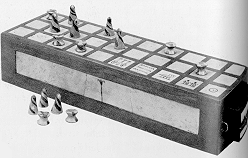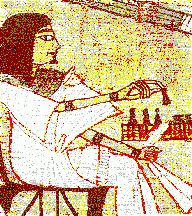
Wood and Ivory senet board
Source : pg.48 Horizon Book of Daily Life in Egypt by: Lionel Casson
The sticks
The pieces
Bumping or Overtaking
Winning the Game
(These rules are paraphrased from the actual game of Senet I have programmed by P.S. Neely - there is a link to that game up above. Please register if you have downloaded it!!)
The board:
The board consists of thirty squares in three rows of ten. The pieces will move in an S-shaped pattern from the upper left
to the lower right passing through all rows. There are two 'good' squares to land on in this type of Senet and one 'bad' square.
The good squares, presented in the recreations as golden, are different in purpose. The square in the second row, located four from the right and five
from the left, is a safety square, protecting the occupant from being bumped or taken over by the opponent. The square in the third row,
located in the same vertical position, is a chance to toss the sticks again. The bad square, represented by blue, symbolizes drowning in the great waters of Nun,
the primordial ocean that will one day again consume the world. It is located three from the right and six from the left. Upon landing on the drowning square,
the piece is moved back to before it ever entered the board.
Instead of dice, Senet uses sticks which are nearly flat, and have one black side and one white side. The white sides count up as numbers. One white side is one, two two and so on until four.
However, if all sides come up as black, it will count as a six. To enter the board, one must either throw a four or a six, the hardest things to come up with in the game. If a four is thrown, the piece
enters in the fourth square of the first row from the left. If a six is thrown, the piece enters the sixth square of that row. Anytime a six is thrown, the player immediately throws the sticks again.
To exit the board, an exact number must be thrown that is the numbers of squares left before the end of the board plus one. This is called 'bearing off'. Anytime a player bears off a piece, they immediately throw
the sticks again. This piece has reached the afterlife and is not dealt with again.
One player is represented by five cones or triangles - favourably green. The other player is represented by five round pieces, sometimes called reels, favourably red.
Whenever a player makes a throw that would cause them to land in a square occupied by the opponent, the opponent's piece is moved back to before it ever entered the board. This causes the opponent to use their fours
and/or sixes to get these pieces back on the board, and it is a goal of either player to do this. A piece occupying the safety or protection square cannot be bumped. The player must move another piece. If another piece cannot be
moved (there are no more maybe) the other player wins for causing a stalemate.
When all five pieces owned by a player have bore off, they have won. Then all pieces advance to the end of the game and it is declared that all have entered
the Afterlife successfully.
Ani playing Senet from "The Book of the Dead" or "The Papyrus of Ani"

Queen Nefertiry playing Senet (Source : pg 48 HBDLE by Lionel Casson)

Animals depicted playing Senet (Source : pg76 HBDLE by Lionel Casson)


